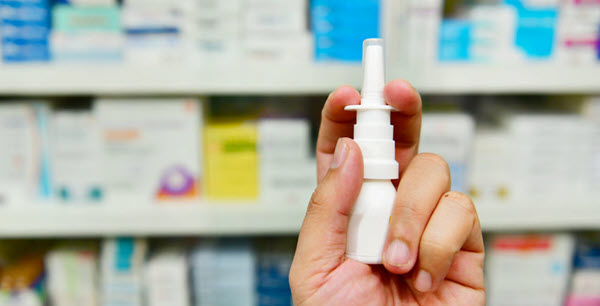 On March 5, 2019, the FDA approved Spravato (esketamine) nasal spray as additive treatment with antidepressants for treatment-resistant depression (TRD). In previous newsletters, I’ve discussed intravenous ketamine as an effective, albeit potentially risky alternative in treatment-resistant cases of depression. But because ketamine is available as a generic, its likelihood of producing a healthy return on investment for drug companies is all but zero, as these firms obviously need hefty profit margins to pursue new product development. Janssen Pharmaceuticals was able to do an end run around this issue by patenting esketamine – which is the ketamine (S) enantiomer. (Think isomer).
On March 5, 2019, the FDA approved Spravato (esketamine) nasal spray as additive treatment with antidepressants for treatment-resistant depression (TRD). In previous newsletters, I’ve discussed intravenous ketamine as an effective, albeit potentially risky alternative in treatment-resistant cases of depression. But because ketamine is available as a generic, its likelihood of producing a healthy return on investment for drug companies is all but zero, as these firms obviously need hefty profit margins to pursue new product development. Janssen Pharmaceuticals was able to do an end run around this issue by patenting esketamine – which is the ketamine (S) enantiomer. (Think isomer).
Esketamine has been subjected to a few clinical trials, both published and unpublished. The findings of the published data line up consistently with the unpublished data. Overall response rates after a month of treatment were much higher for esketamine plus an antidepressant, when compared to placebo plus an antidepressant. Also in a long-term maintenance trial, the midpoint time to relapse in stable responders to the esketamine-antidepressant combination was a whopping 635 days (1.75 years), whereas those randomized to the placebo-antidepressant combination realized only three months before relapse occurred.
So far, esketamine has been well tolerated. The mostly commonly reported side effects are a bitter aftertaste post administration, nausea, dizziness and some sedation. Esketamine does raise blood pressure a bit, peaking at about 40 minutes after a dose, before gradually remitting to previous baseline levels. Similar to ketamine, dissociation – manifesting as a “freefloating” feeling or a sense of feeling “drugged” – is often reported with esketamine. These sensations tend to remit within an hour or two.
Esketamine is classified as a Schedule III controlled substance and has its own set of regulations. Providers of this agent must sign up with the REMS (Risk Evaluation and Mitigation Strategy) system, and the Drug Enforcement Administration (DEA) performs an inspection of a provider’s office. A provider is mandated to supervise a patient while the intranasal dose is self-administered, and the supervision must be ongoing for at least 2 hours afterward to monitor for side effects. Patients are instructed not to drive on administration days and are prohibited from taking the medication home.
Esketamine is the first, really new and original antidepressant to reach the U.S. market in over 30 years. Although only approved for treatment-resistant depression for now, it appears to be a viable alternative for providing rapid relief for bouts of severe depression and suicidality, which makes it a standout, for sure. It can provide practically immediate relief, the benefits of which can be maintained with continual dosing. The science of this drug – which is piggybacking off of the success of IV ketamine – seems sound, and is rather impressive. But we’ve been down this road before many, many times. Exuberance regarding novel drugs with ballyhooed initial success so often doesn’t continue to shine down the line. So we await the acid test – how well esketamine holds its own against other treatment-resistant medication options (combinations, ECT) for severe, intractable depression.
The recommended dosing guidelines for esketamine are as follows: 56-84 mg intranasally – together with an antidepressant. Recommended dosing schedule: Weeks 1-4: twice weekly; Weeks 5-8: once weekly; post week 8: every 1-2 weeks.
Esketamine runs about $600 for each 56mg dose and nearly $900 for each 84mg dose. Monthly maintenance treatment could total up to $3500 per month – depending on dosing frequencies. (This $3500 fee excludes costs incurred for clinical monitoring and oversight). Insurance coverage runs the gamut from being inconsistent to nonexistent depending on the plan and coverage parameters.
The FDA likely acted quickly on this agent because of the urgent need for something new for patients truly suffering from TRD; and if esketamine acquits itself well, look for the floodgates to open, suggesting it be tried for bipolar depression and anxiety disorders as well.
Attribution Statement:
Joe Wegmann is a licensed pharmacist & clinical social worker has presented psychopharmacology seminars to over 10,000 healthcare professionals in 46 states, and maintains an active psychotherapy practice specializing in the treatment of depression and anxiety. He is the author of Psychopharmacology: Straight Talk on Mental Health Medications, published by PESI, Inc.
To learn more about Joe’s programs, visit the Programs section of this website or contribute a question for Joe to answer in a future article: joe@thepharmatherapist.com.